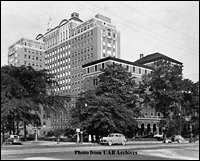 In spring 1910, a Carnegie Foundation report conducted by one Abraham Flexner to evaluate conditions at the nation’s medical schools, found the Birmingham Medical College and the Medical College of Alabama in Mobile to be lacking in funding, equipment, and “continuity of clinical instruction.” The Flexner Report’s conclusion that “[R]eally satisfactory medical education is not now to be had in Alabama,” was a severe blow to a state coping with dire poverty, two previous yellow fever epidemics and a dearth of trained physicians. Undaunted, Alabama would forge on in its efforts toward not just “satisfactory,” but highest quality medical training and care.
In spring 1910, a Carnegie Foundation report conducted by one Abraham Flexner to evaluate conditions at the nation’s medical schools, found the Birmingham Medical College and the Medical College of Alabama in Mobile to be lacking in funding, equipment, and “continuity of clinical instruction.” The Flexner Report’s conclusion that “[R]eally satisfactory medical education is not now to be had in Alabama,” was a severe blow to a state coping with dire poverty, two previous yellow fever epidemics and a dearth of trained physicians. Undaunted, Alabama would forge on in its efforts toward not just “satisfactory,” but highest quality medical training and care.
Eighty years later, the dean of a reconstituted school of medicine in Birmingham, Dr. James A. Pittman, received the coveted Abraham Flexner Award for Distinguished Medical Education. In that same year, U.S. News and World Report listed “University of Alabama, Birmingham” first among the best “up and coming” medical schools in the country, and the school was ranked 23rd in NIH funding.
“This was an exciting time in the history of the University of Alabama at Birmingham,” recounts Dr. Wayne Finley. “Dean Pittman noted in 1991 that the new West Pavilion of University Hospital had opened that year, the new Psychiatric Hospital would open in 1992, and the Kirklin Clinic would open in April 1992. The physical plant was being enlarged at a rapid pace...[and] had been proceeding at a significant rate for at least twenty years and the new century started with some of the largest projects ever undertaken.”
Over the course of a century, the cumulative expertise, resources and aspirations of the Medical College of Alabama in Mobile (1859-1920), Birmingham Medical College (1895-1915), the two-year pre-clinical School of Medicine at Tuscaloosa (1920-1945), and the Medical College of Alabama in Birmingham (1945-1969), all coalesced in 1969 into a singular entity, and identity, rooted in Birmingham and respected around the globe.
 In spring 1910, a Carnegie Foundation report conducted by one Abraham Flexner to evaluate conditions at the nation’s medical schools, found the Birmingham Medical College and the Medical College of Alabama in Mobile to be lacking in funding, equipment, and “continuity of clinical instruction.” The Flexner Report’s conclusion that “[R]eally satisfactory medical education is not now to be had in Alabama,” was a severe blow to a state coping with dire poverty, two previous yellow fever epidemics and a dearth of trained physicians. Undaunted, Alabama would forge on in its efforts toward not just “satisfactory,” but highest quality medical training and care.
In spring 1910, a Carnegie Foundation report conducted by one Abraham Flexner to evaluate conditions at the nation’s medical schools, found the Birmingham Medical College and the Medical College of Alabama in Mobile to be lacking in funding, equipment, and “continuity of clinical instruction.” The Flexner Report’s conclusion that “[R]eally satisfactory medical education is not now to be had in Alabama,” was a severe blow to a state coping with dire poverty, two previous yellow fever epidemics and a dearth of trained physicians. Undaunted, Alabama would forge on in its efforts toward not just “satisfactory,” but highest quality medical training and care.